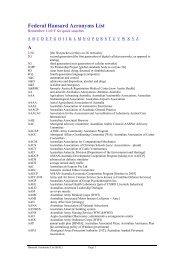Book 8 - Parliament of Victoria
Book 8 - Parliament of Victoria
Book 8 - Parliament of Victoria
Create successful ePaper yourself
Turn your PDF publications into a flip-book with our unique Google optimized e-Paper software.
AUSTRALIAN SYNCHROTRON: FUNDING<br />
1642 COUNCIL Wednesday, 1 June 2011<br />
innovation-intensive, high-technology,<br />
high-value-added, high-wage, high-skill manufacturing<br />
sector.<br />
The industry assistance and grants provided by the<br />
Bracks and Brumby governments over their 11 years<br />
have facilitated this transformation. The development<br />
<strong>of</strong> the Australian Synchrotron is one example <strong>of</strong> this<br />
transformation. As a consequence <strong>Victoria</strong>n<br />
manufacturers now have a competitive advantage and<br />
must continue to develop that advantage in cutting-edge<br />
capabilities, including the utilisation <strong>of</strong> advanced<br />
manufacturing processes, materials and technologies in<br />
areas such as scientific and medical instruments,<br />
specialist engineering and aerospace industries.<br />
Let us now have a look at how the Australian<br />
Synchrotron has engaged with industry. The Australian<br />
Synchrotron has contributed to not only the <strong>Victoria</strong>n<br />
economy but also the national economy. It has done<br />
this by providing services to commercial users and<br />
promoting collaboration between science and industry.<br />
As I said earlier, it is not common knowledge how<br />
much work the synchrotron does with industry, but it<br />
does a lot, hence my moving <strong>of</strong> this motion today. I will<br />
outline some <strong>of</strong> the things the synchrotron has done<br />
with industry. The Australian Synchrotron has linkages,<br />
either directly or via its users, with at least 88 individual<br />
companies, and 30 <strong>of</strong> those companies are involved in<br />
linkage grants that mention the use <strong>of</strong> the Australian<br />
Synchrotron.<br />
Commercial companies that have used the Australian<br />
Synchrotron include small and medium enterprises<br />
such as Aximill, Techniques Incorporated, global<br />
biotherapy leader CSL Ltd and other successful<br />
biopharmaceutical companies. More than 60 tours <strong>of</strong><br />
the synchrotron have been conducted for a wide variety<br />
<strong>of</strong> industry sectors, with groups coming from Agilent<br />
Technologies, Hospira global pharmaceuticals, Wacker<br />
Chemicals Australia, Amcor, Siemens Australia,<br />
Phosphagenics Ltd, the University <strong>of</strong> Queensland,<br />
St Vincent’s Hospital, BASF and Telstra operations.<br />
The synchrotron’s business development activities<br />
include active participation in and support for initiatives<br />
and organisations that facilitate interaction between<br />
science and business, including by hosting or<br />
organising visits and events. For example, in May 2011<br />
the Australian Nanotechnology Alliance, which focuses<br />
on economic growth in <strong>Victoria</strong> and Australia, held a<br />
networking event at the synchrotron that attracted over<br />
70 industry participants. There are numerous specific<br />
examples <strong>of</strong> the manufacturing sector benefiting from<br />
the cutting-edge techniques <strong>of</strong> the Australian<br />
Synchrotron, which plays a key role in that space, but I<br />
will not go through all <strong>of</strong> them given that we are<br />
running out <strong>of</strong> time. However, I will convey to the<br />
house a particularly relevant and symbolic example.<br />
The saying ‘Living <strong>of</strong>f the sheep’s back’ conjures up<br />
the image <strong>of</strong> an Australian economy that lacks<br />
technological know-how or lacks the will to value-add<br />
to our natural resources — the old quarry mentality, if<br />
you like. It is highly symbolic that the perhaps<br />
soon-to-be-closed Australian Synchrotron has come up<br />
with a method <strong>of</strong> value-adding for sheepskin. The<br />
problem with sheepskin is that it cannot be used in a<br />
variety <strong>of</strong> commercial applications because <strong>of</strong> its lack<br />
<strong>of</strong> strength. By using Australian Synchrotron tools<br />
essential to this problem, scientists are studying the<br />
nanoscale structure <strong>of</strong> sheep leather.<br />
The benefit <strong>of</strong> this is that based on a better<br />
understanding <strong>of</strong> the molecular properties making up<br />
sheepskin, new treatment and processing strategies<br />
have been developed to increase its strength and<br />
commercial applications. The annual return from this<br />
change potentially amounts to an additional<br />
$118 million per year for the Australian industry. That<br />
is a lot <strong>of</strong> money and I would have thought on its own a<br />
pretty good reason to keep the synchrotron open. There<br />
we have it: the Australian Synchrotron solving one <strong>of</strong><br />
the most intractable problems in our economy — that<br />
is, how we value-add to our natural resources.<br />
As can be seen from the examples I have cited, the<br />
Australian Synchrotron is a significant contributor to<br />
the <strong>Victoria</strong>n and national manufacturing sectors and to<br />
industry as a whole, and therefore to our economy.<br />
Many <strong>of</strong> the techniques used and developed by the<br />
Australian Synchrotron are vital in continuing to<br />
develop the <strong>Victoria</strong>n manufacturing sector’s<br />
competitive advantage in cutting-edge capabilities and<br />
technology. The failure <strong>of</strong> the Baillieu government to<br />
commit ongoing funding for the synchrotron — —<br />
Mrs Peulich — What have you been doing for<br />
11 years?<br />
Mr SOMYUREK — Funding the synchrotron. The<br />
Baillieu government’s failure to commit ongoing<br />
funding for the synchrotron puts further pressure on<br />
<strong>Victoria</strong>n advanced manufacturing sector by potentially<br />
depriving industry <strong>of</strong> a major tool for research and<br />
development. The development <strong>of</strong> advanced new<br />
products and processes is one <strong>of</strong> the keys to<br />
maintaining and growing <strong>Victoria</strong>’s manufacturing<br />
base, and the synchrotron has a significant role to play<br />
in those developments.
















